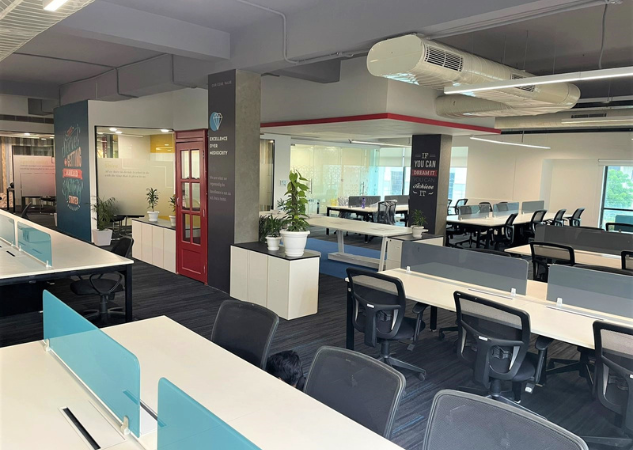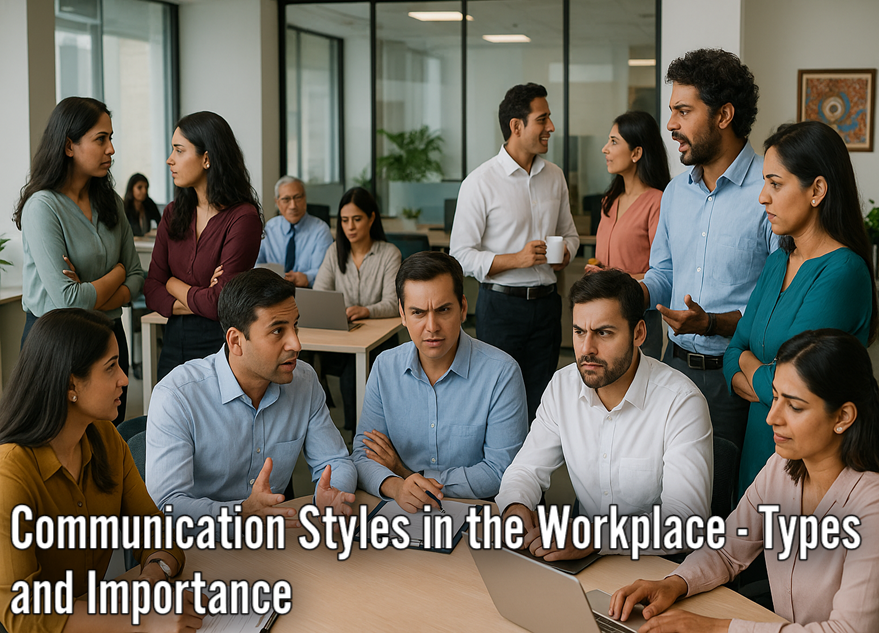Understanding workplace communication styles boosts teamwork, productivity, and inclusivity. Learn why they matter for a thriving work culture.
💡 Are you looking for Coworking space in Gurgaon, Noida or Delhi? We are just a call away.
Call Now: 08999 828282
10 Types of Communication Styles and Their Importance
- Assertive Communication
- Passive Communication
- Aggressive Communication
- Passive-Aggressive Communication
- Emotional Communication
- Nonverbal Communication
- Formal Communication
- Informal Communication
- Written Communication
- Verbal Communication
1. Assertive Communication
- What it is: Assertive communication involves expressing thoughts and feelings openly while respecting others.
- Importance: It promotes clarity and respect, enabling people to share their views without fear. Assertive communicators set clear boundaries and are often seen as confident leaders.

2. Passive Communication
- What it is: Passive communicators often avoid expressing their feelings or opinions. They tend to go along with others rather than asserting themselves.
- Importance: While passive communication can prevent conflict, it can also lead to frustration and misunderstandings. Recognizing this style helps managers encourage more open communication from quieter team members.
3. Aggressive Communication
- What it is: Aggressive communication is marked by a strong need to express oneself, often at the expense of others’ opinions. It can come off as confrontational.
- Importance: Understanding aggressive communication helps create a balanced approach to disagreements. Workplaces benefit when team members recognize this style and work to be more respectful and constructive.
4. Passive-Aggressive Communication
- What it is: Passive-aggressive communicators may appear passive on the surface but express dissatisfaction indirectly, often through sarcasm or subtle jabs.
- Importance: Recognizing passive-aggressive communication helps address underlying issues before they grow into larger conflicts. It encourages honesty and transparency in the workplace.
Also Read: 10 Passive Revenue Ideas for Small Business Owners
5. Emotional Communication
- What it is: Emotional communication involves sharing feelings openly. It can be positive, like enthusiasm, or negative, like frustration.
- Importance: Expressing emotions can foster a supportive office culture, but it must be managed to prevent misunderstandings. Knowing when and how to share emotions is key to maintaining professionalism.
6. Nonverbal Communication
- What it is: Nonverbal communication includes body language, facial expressions, and tone of voice. It often conveys more than words alone.
- Importance: Being aware of nonverbal cues can enhance understanding and empathy in the workplace. For instance, maintaining eye contact shows attentiveness, and a friendly tone fosters a welcoming atmosphere.
7. Formal Communication
- What it is: Formal communication follows a professional structure, often in meetings, emails, or reports. It is clear, direct, and business-oriented.
- Importance: Formal communication is crucial for conveying official information, ensuring everyone has the same understanding. It sets the standard for professional interactions within the company.
8. Informal Communication
- What it is: Informal communication is casual and often occurs among coworkers as part of team bonding. This can include small talk or quick, friendly conversations.
- Importance: Informal communication helps build camaraderie and trust among employees. It promotes a positive work environment and makes people feel comfortable interacting with each other.
9. Written Communication
- What it is: Written communication includes emails, reports, and messages. It provides a record of exchanges and is often used to share detailed information.
- Importance: Written communication is effective for tracking discussions and sharing information that others can reference later. It’s essential for clarity, especially in remote work environments.
10. Verbal Communication
- What it is: Verbal communication is spoken communication, whether in meetings, presentations, or casual discussions.
- Importance: Verbal communication allows for real-time interaction, immediate feedback, and clarity. It’s especially useful for discussions that need quick answers or brainstorming sessions.
💡 SMBs looking for HR, Marketing, Technology and Funding solutions for their business.
Call Hello Jarvis 994 8000 800
Why Understanding Communication Styles is Important?
Each communication style brings unique benefits and challenges to the workplace. By understanding these styles, employees can adapt to different situations, communicate more effectively with various personalities, and create a more inclusive and collaborative environment.
- Improves Team Collaboration: Knowing each other’s communication styles helps teams collaborate better and respect individual preferences.
- Reduces Misunderstandings: Misinterpretation is common in communication, but being aware of styles can reduce conflicts.
- Builds Stronger Relationships: When employees understand each other’s styles, they’re more likely to support and trust each other.
- Enhances Problem Solving: Different styles bring different perspectives, which can lead to more creative solutions and better decision-making.
- Increases Productivity: Clear, effective communication helps teams focus on their tasks without being hindered by unnecessary confusion or conflict.
Mastering effective communication in the workplace is crucial for building strong teams, fostering collaboration, and achieving business success. For teams looking to enhance their communication and collaboration, The Office Pass (TOP) co-working spaces in Delhi and NCR offer an ideal environment. With modern amenities, dedicated workspaces, and areas designed for relaxation and focus, TOP provides the flexibility and resources teams need to thrive. Whether you’re brainstorming in a collaborative setting or taking a break in a calming lounge, TOP ensures that your team remains motivated and connected. Explore how TOP can transform your workspace and support your team’s success by contacting at 08999 828282.
FREQUENTLY ASKED QUESTIONS (FAQS):
Question: What are communication styles in the workplace?
Answer: Communication styles refer to the different ways people express themselves and share information with others in a work setting. These styles can influence how we interact, solve problems, and build relationships with colleagues.
Question: Why are communication styles important at work?
Answer: Understanding communication styles is essential because it helps create clear, effective exchanges between coworkers. It reduces misunderstandings, improves teamwork, and fosters a more positive and productive workplace environment.
Question: What are the main types of communication styles?
Answer: The four main types of communication styles are assertive, passive, aggressive, and passive-aggressive. Assertive communication is clear, direct, and respectful. Passive communication avoids conflict and often leads to not speaking up. Aggressive communication is dominant and sometimes disregards others’ opinions. Passive-aggressive communication appears passive but expresses frustration indirectly.
Question: How can I identify my own communication style?
Answer: Observe how you typically respond to others in different situations. For example, do you avoid conflicts, speak openly, or feel frustrated without saying much? Self-reflection and feedback from trusted colleagues can also help you identify your style.
Question: How do different communication styles impact teamwork?
Answer: People with different communication styles may approach tasks and discussions differently, which can lead to misunderstandings or conflict. But when everyone understands each other’s style, it becomes easier to adapt and collaborate effectively.
Question: Can I change my communication style?
Answer: Yes, you can adjust your style depending on the situation. Practicing assertive communication, for example, can help improve clarity and respect in conversations. Flexibility in communication often leads to better workplace relationships.
Question: Why is assertive communication usually considered the best style?
Answer: Assertive communication is clear, respectful, and direct. It allows people to express their thoughts honestly without being overbearing or dismissive. This approach tends to create positive interactions and minimizes conflict.
Question: How can I communicate better with someone who has a different style than mine?
Answer: Try to understand their style and adapt your approach. For example, if someone is more passive, encourage them to share their ideas. If someone is more aggressive, try to stay calm and assertive to keep the conversation balanced.
Question: What problems can arise from poor communication styles?
Answer: Poor communication can lead to misunderstandings, conflicts, and even a decrease in team morale. People may feel undervalued or ignored, which can harm workplace relationships and reduce overall productivity.
Question: How can managers support different communication styles in the workplace?
Answer: Managers can foster an inclusive environment by encouraging open communication, providing training on different communication styles, and promoting a culture of respect. This support helps everyone feel comfortable sharing their ideas in ways that work best for them.



